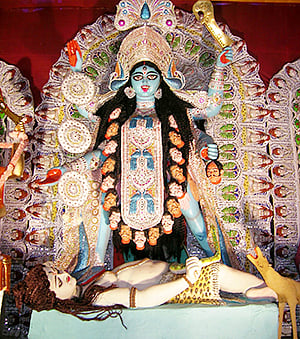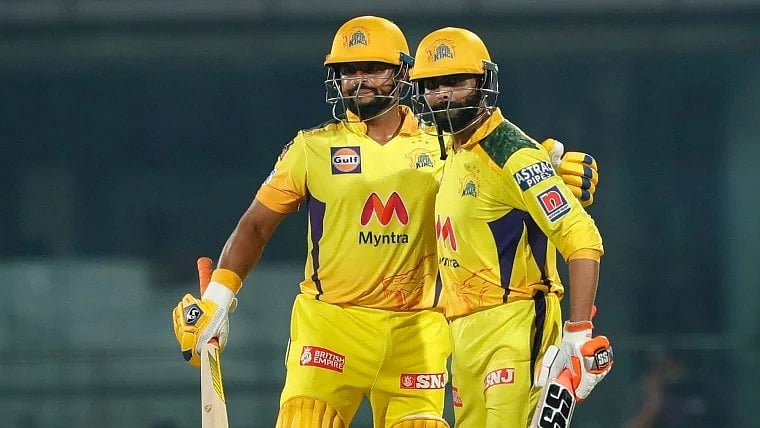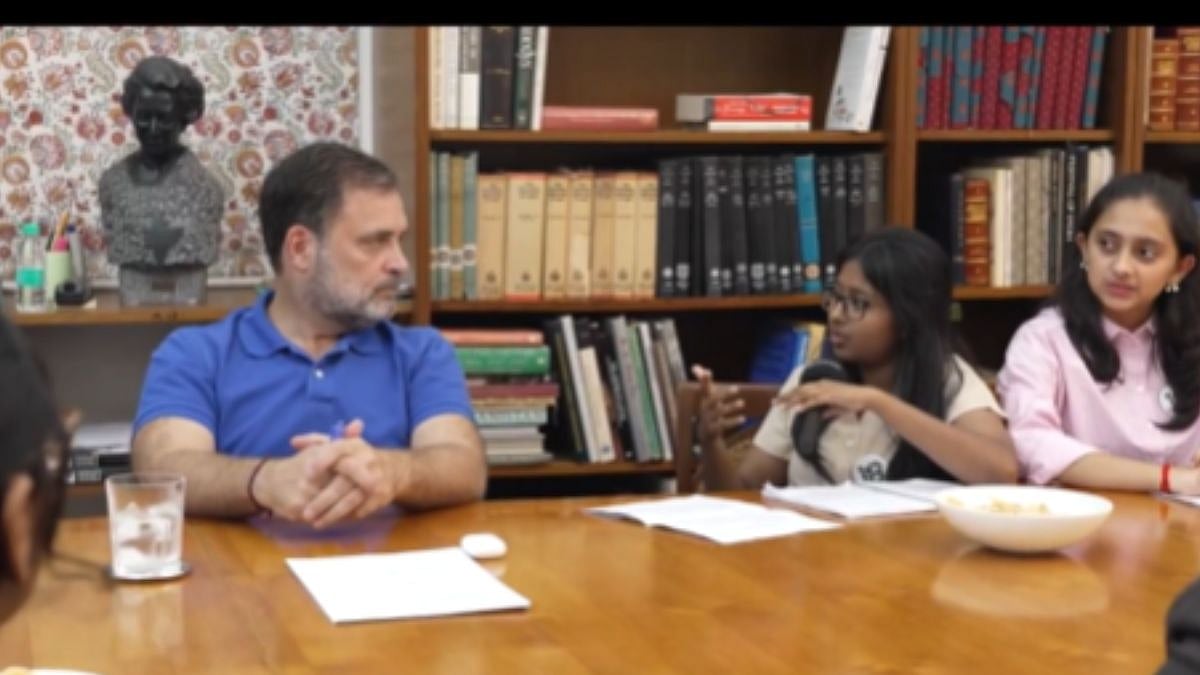While Bengalis, Oriyas and Assamese adore goddess Kali on this day, the rest of India worships goddess Lakshmi on Diwali, writes MEERA S. SASHITAL.In Bengal, Diwali is celebrated as Kali Puja and also known as Shyama puja. Here the Diwali festival is dedicated to the Hindu Goddess Kali and is celebrated on the new moon day of the month of Kartik. It coincides with the Lakshmi puja, the third day of Diwali, which though falls on Amavasya day is regarded as the most auspicious. While Bengalis, Oriyas and Assamese adore goddess Kali on this day, the rest of India worships goddess Lakshmi on Diwali.
Goddess Kali is represented in the scriptures as a black woman with four arms; in one hand she has a sword, in another the head of the giant she has slain. The other two hands are for Abhaya Mudra i.e. protection and Varada Mudra for granting boons. She wears a necklace of skulls and for earrings two dead bodies. Her only clothing is a girdle of apron of human hands with her tongue protruding from her mouth. She has three eyes and her face is red. She is standing with one foot on the thigh and another on the breast of her husband Shiva.
The severed head and the sword are, we are told, the graphic representations of destruction that has just taken place. She is termed ‘Digambara’ (clad in space), having the vast limitless space itself as her only vesture. She is black as she represents the state where time, space and causation have disappeared. Her apron of severed hands stand for potential energy and her dishevelled hair for her untrammelled freedom.
The position of her standing on the chest of Shiva, according to mythological account, tells us that when her victory over the giants was won, she danced for joy so furiously that the earth trembled beneath her weight. At the request of the Gods, Shiva asked her to desist. As due to her excitement she paid no heed to him, Shiva lay down among the slain on whom she was dancing in order to absorb its shock into himself.
When she stepped upon him she suddenly realised her mistake and put out her tongue in shame at the disrespect she had shown him and for causing destruction. Shiva is Brahman, the Absolute which is beyond all names, forms and activities. Hence he is shown lying prostrate like a corpse. Kali represents his shakti or energy which can never exist apart from its source or act independently of it. Though Goddess kali in appearance is fearful, She is the embodiment of Love and Kindness ever ready to fulfill the prayers of Her devotees.
One of the famous temples dedicated to Goddess Kali is the Kalighat Kali temple in Calcutta. Kalighat was a Ghat (landing stage) sacred to Kali on the old course of Hooghly River (Bhagirathi) in the city of Calcutta. The name Calcutta is said to have derived from the word Kalighat. Thousands of pilgrims from all over India flock to the Kalighat temple and treat Kali very much like a human mother praying to her to solve all their problems. Kalighat is regarded as one of the 51 Shakti Peethas of India, where the various parts of Sati’s body are said to have fallen, in the course of Shiva’s Rudra Tandav.
Kalighat represents the site where the toes of the right foot of Dakshayani or Sati fell The legend of Sati is associated with the destruction of Daksha’s sacrifice and the origin of the Shakti Peethas. Sati, the wife of Shiva was the daughter of Daksha. She had married Shiva against the wishes of her father. When Daksha performed a Yagnya, he invited all the gods and goddesses except Shiva. Sati attended the sacrifice against Shiva’s wishes and was insulted by her father. Unable to bear the insult, Sati immolated herself on the Homa. Crazed with grief Shiva picked up the remains of Sati’s body and danced the Dance of Destruction throughout the Universe. To stop this Dance, Vishnu cut with His disc the body of Sati whose various parts fell at several spots all throughout India and formed the sites of what are known as Shakti Peethas today.
Legend has it that a devotee initially discovered an illuminant ray of light coming from the Bhagirathi river bed. Upon investigating its source he came upon a piece of stone carved in the form of a human toe. He also found a Svayambhu Lingam of Nakuleshwar Bhairav nearby and started worshipping Kali in the midst of a thick jungle. The temple was built by a Brahmin Zamindar, Sabarna Roy Choudary.
The image of Kali in this temple is unique unlike the other Kali images of Bengal. It seems the present idol of touchstone was created by two saints, Brahmanand Giri and Atmaram Giri. Three eyes, long protruding tongue and four hands are all made of gold. Two of these hands hold a scimitar and a severed head of the asura king “Shumbha”.
The scimitar signifies Divine Knowledge and the asura (or human) head signifies human ego which must be slain by Divine Knowledge to attain Moksha.. The other two hands are in the Abhaya and Varada Mudras or blessings assuring her devotees that She will forever protect and save them. It is said human sacrifices were offered formerly to Kali, though now they have been forbidden both by British law and the Hindu Scriptures too. However, Her devotees having faith in Her have always had their prayers answered. One of the greatest devotee of Kali, as we all know, was Sri Ramkrishna Paramhauns.
Kali Puja as Diwali is celebrated with illuminations and bursting of crackers. It is a day of rejoicing to mark the victory of Goddess Kali over the demons and wickedness and, ultimately the triumph of Good over Evil.









